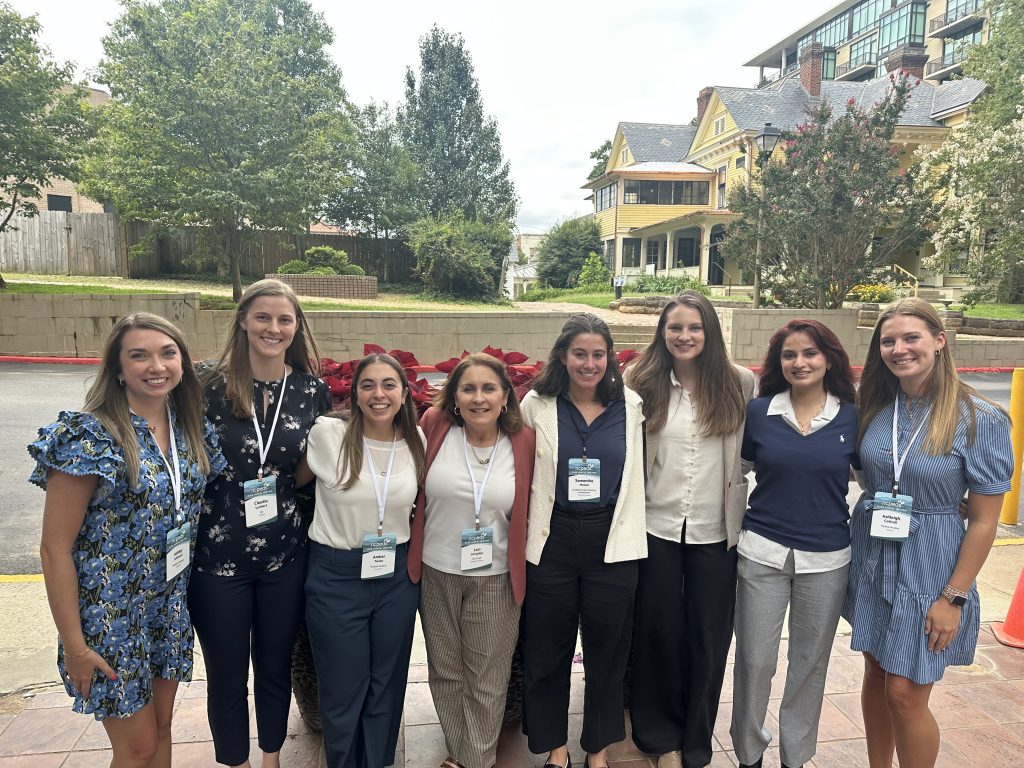Fewer physicians are becoming pediatricians, who continue to confront myriad and mounting challenges.
Cuts to Medicaid and similar funding programs are affecting rural populations, most notably children, who are often hurt by current immigration policies. Louder voices questioning the need and efficacy of vaccines are sowing confusion, in some cases eroding trust and raising baseless doubts.
A meeting of the N.C. Pediatric Society (NCPeds) in August addressed these crucial issues, and many others.
Professors, doctors and student doctors representing Campbell University attended the annual N.C. Pediatric Society meeting in Asheville, bringing together pediatricians, professors, student doctors and other healthcare leaders from throughout the state.
NCPeds is the N.C. Chapter of the American Academy of Pediatrics and a leading authority, advocate and voice for the health of our state’s children and for the profession of pediatrics, representing more than 2,000 pediatric health care providers in North Carolina, the pediatricians’ group says.
Seven students from the Jerry M. Wallace School of Osteopathic Medicine attended the conference, which included representatives from the University of North Carolina, as well as Duke, Wake Forest and East Carolina universities.
Dr. Lori Langdon, clinical chair of Pediatrics and assistant professor at the med school, is on the leadership team for the N.C. Pediatric Society. She accompanied the student doctors — Ashley Johnson, Ashleigh Cottrell, Samantha Meisel, Vivian Ryan, Amber Tuske, Claudia Lenhart and Aaditi Kulkarni.
Ryan of Nashville, Tennessee, and a second-year med student at Campbell, says she is drawn to pediatrics because it blends science with advocacy, the doctors working not only to treat children but also to support families and communities.
“Attending the N.C. Pediatric Society meeting … gave me a deeper sense of the collaborative spirit in pediatrics,” Ryan says. “I learned so much from hearing physicians discuss current challenges in child health, from vaccine confidence to health equity, and I left feeling even more motivated to pursue a career where I can contribute to both patient care and broader conversations about children’s health.”
Langdon is encouraged by the number of Campbell med students who traveled with her to Asheville.
“We had the most students of any other medical school there,” says Langdon, who spoke on the impact of Medicaid cuts to rural areas and the importance of dedicated pediatric preceptors to model the fulfillment from a career caring for children.
The students got the chance to network and had access to all of the lectures, covering vaccines, immigration policies, the effects of healthcare funding cuts on N.C. children in North Carolina and the importance of advocacy regarding children’s health. Attendees also got updates on clinical topics from specialists in their respective fields.
“Given our current pediatrician shortage and projected worsening workforce issues, everyone is eager to welcome and encourage future pediatricians,” Langdon says.
After Match Day last year — when graduating student doctors learn about their residencies — many U.S. residency programs found out that they did not successfully fill their incoming classes of future pediatricians, the JAMA reported in July.
“Compared with match results since 2017, with fill rates hovering around 98%, this year (2024) only 91.8% of pediatric residency slots were successfully filled by programs before the supplemental phase of the match.”
That jumped to 95 percent in 2025, Langdon says.
Applications to pediatrics programs from allopathic programs have been decreasing over the past five years, however, JAMA says.
Financial burdens, such as relatively low pay among other medical specialties and heavy debt loads, JAMA says, are reasons for the shortage, among other issues, such as dwindling resources, restrictive laws and administrative hurdles.
All of Campbell’s 154 graduating medical students in 2025 were placed in a residency program. Thirty-two of the graduating students were specializing in family medicine and 29 in internal medicine. Seventeen Campbell students chose to pursue a career in pediatrics.
In her autobiography, “Doctors Work in Air Conditioning: An Intimate look at Southern Culture and the Challenges of Rural Medicine,” Langdon says pediatrics is at a crossroads.
She acknowledges recruiting pediatricians to serve in rural areas is a challenge, though Campbell is doing well in this regard. She offers several strategies, such as recruiting more students from rural areas and having more third- and fourth-year students complete their clinical rotations in rural areas.
“We need to recruit more medical students to choose it as a career,” says Langdon, closing her book by restating her commitment to advocate for children.
“We need to encourage life-saving vaccinations, reimburse pediatricians appropriately and fight to improve the quality of healthcare in rural areas.”

